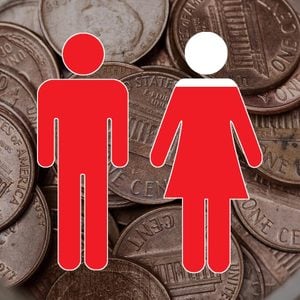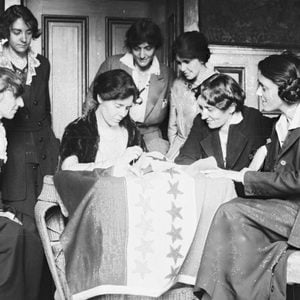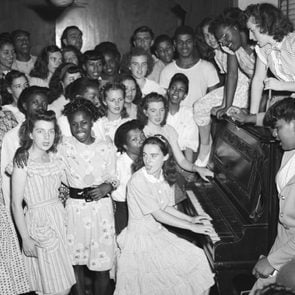15 Ways Justice Ruth Bader Ginsburg Has Made History
Updated: Feb. 06, 2023
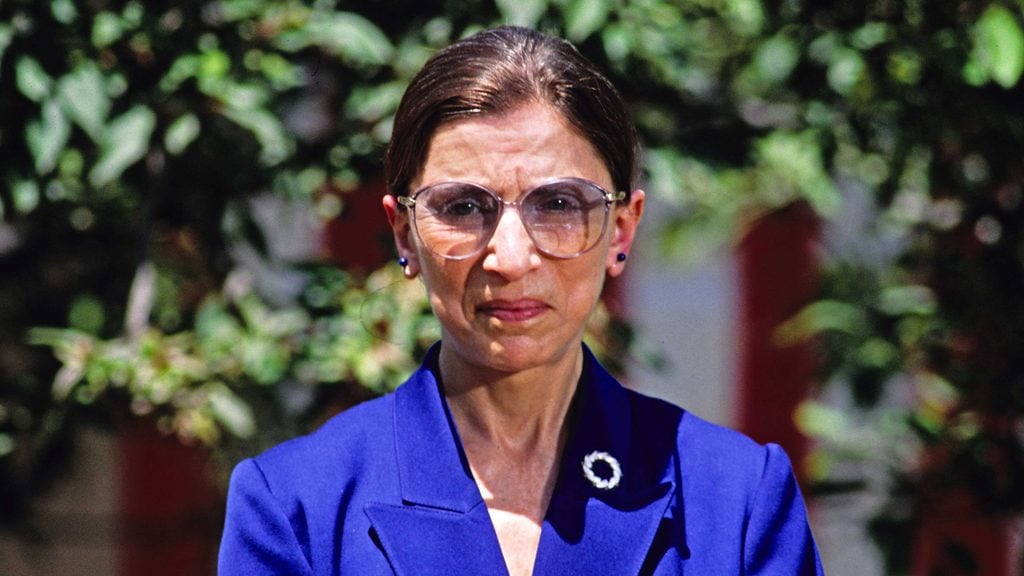
On September 18, 2020, Ruth Bader Ginsburg passed away at the age of 87. The pint-sized powerhouse broke barriers both in her personal and professional life to become a Supreme Court Judge and pop culture icon. Here's what makes RBG's accomplishments so groundbreaking.
She fought tirelessly for gender equality under the law. She battled sexism in her own life and career. She juggled motherhood and caring for her cancer-stricken husband while still in law school. As a Supreme Court Justice, she was a role model for what every young girl (and every adult woman, for that matter) is capable of achieving. She is Ruth Bader Ginsburg.
What makes RBG, as she is known, such a force of nature? “She understood exactly what kind of change she wanted to make—and be—in the world because she had experienced it so personally,” says Katherine Franke, Columbia Law School professor and Director of the Center for Gender and Sexuality Law, who was a part of a symposium in 2013 in honor of Justice Ginsburg. In their book Notorious RBG, lawyer Shana Knizhnik, who started the viral “Notorious RBG” Tumblr, and journalist Irin Carmon write, “RBG is a woman who, to use another phrase that mattered a lot to her, defied stereotypes…RBG was already a radical just by being herself—a woman who beat the odds to make her mark.”
Up until the end of her life, the octogenarian showed no signs of slowing down. Take a look at some of Justice Ginsburg’s amazing achievements.
She graduated first in her class from Columbia Law School
Encouraged to pursue education by her mother, Ginsburg graduated in 1954 from Cornell University, where she met her future husband, Martin, then got married and had her first child. Two years later, she went on to law school at Harvard, one of nine women in a class of 500, and transferred to Columbia when her husband got a job in New York. “The study of law was unusual for women of my generation. For most girls growing up in the ’40s, the most important degree was not your BA, but your MRS,” Ginsburg said, according to the ACLU. She decided to go to law school for “personal, selfish reasons. I thought I could do a lawyer’s job better than any other.” RBG wasn’t wrong: She tied for first in her class at Columbia.
She battled—and overcame—sexism personally
But her educational victories weren’t without struggle. “Ginsburg comes from the generation of women who had to be three times better than men in order to get half the recognition of the average man—this was surely her experience at Harvard and Columbia Law Schools,” Franke says. “Her professors in law school were no doubt unfamiliar with having an outstanding female student in their classrooms.” One professor even offered to give Ginsburg answers on a test in exchange for sex. Yet, unlike many women of her time, she didn’t accept that kind of treatment as just the way things were. “I went to his office and I said, ‘How dare you! How dare you do this!’ and that was the end of that,” she said last year at the Sundance Film Festival, where the documentary RBG premiered.
She was the first person on both the Harvard and Columbia law reviews
While in law school, Ginsburg experienced sexism not only from her professors but her fellow students as well. “I imagine that the hazing she got from her male classmates was even worse than the discriminatory treatment she experienced from her professors,” Franke says. “They were not going to tolerate a woman besting them in their classes.” Even so, Ginsburg became the first person, male or female, to become a member of both the Harvard and the Columbia Law Reviews, student-run journals of legal scholarship.
She became the second female law professor at Rutgers—and fought for equal pay
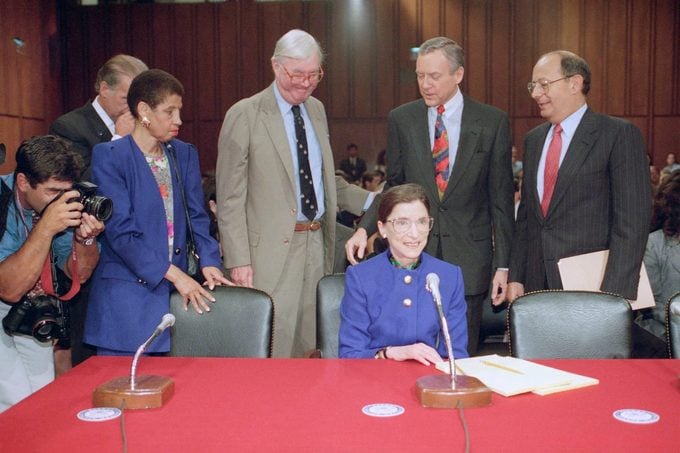
Even with all her law school accolades, Ginsburg faced more discrimination when looking for a job after graduating. “I struck out on three grounds,” she said in 1993 of her trouble getting hired. “I was Jewish, a woman, and a mother. The first raised one eyebrow; the second, two; the third made me indubitably inadmissible.”
Eventually, she became one of a handful of female law professors in the country when she was hired in 1963 at Rutgers Law School—but as the second female law professor there, she still had to fight for pay equality. When asked why a male counterpart was being paid more, “the dean replied, ‘Ruth, he has a wife and two children to support. You have a husband with a good-paying job in New York,'” Ginsburg said at Sundance. “That was the very year the Equal Pay Act had passed, that was the answer I got.” So, she and other female employees filed an Equal Pay Act complaint—and won.
She co-founded the first law journal on women’s rights
At her students’ request in 1969, Ginsburg started teaching a seminar on women and the law. “Rutgers students sparked my interest and aided in charting the course I then pursued,” Ginsburg said in a short film by the university. As she began to find her niche in women’s legal rights, she co-founded and became the faculty advisor for the first law journal to focus on the topic, the Women’s Rights Law Reporter. “As faculty advisor, Professor Ginsburg devoted many hours to writing and editing, counseling the staff, attending meetings, and inevitably mediating with the administration when problems arose,” writes co-founder Elizabeth Langer on Columbia’s Barnard College website. “Forty years later, it is still publishing at Rutgers Law School—the first among many current legal publications devoted to women’s issues.”
She became the first tenured female law professor at Columbia
Ginsburg became the first tenured female Columbia Law School professor after joining the faculty in 1972. “It must have been exhilarating for the female students at Columbia when Ruth Bader Ginsburg was hired as a tenured professor,” Franke says. “It is so important for students to see themselves reflected in the person standing at the front of the room.” At the same time, “the pressures on Professor Ginsburg to be an exemplar for her sex were surely weighty. It’s never easy being the first and the only representative of your class of people.” While at Columbia, she co-authored the first law school casebook on sex discrimination in 1974.
But RBG didn’t see her employer as above the law, no matter what position it had afforded her: She championed the rights of the school’s female maids, who were being laid off before the male janitors; she also fought on behalf of female employees to receive the same retirement benefits as men. Again and again, she won. Ginsburg was becoming one of the inspiring women who are changing the lives of women.
She co-founded the Women’s Rights Project at ACLU
Also in 1972, she co-founded the Women’s Rights Project at ACLU (American Civil Liberties Union), as the organization began referring sex-discrimination cases to her. She took up the mantle of litigating gender inequality cases with measured, conservative baby steps, tackling one law at a time, because she thought radical change would be too much too soon. But still, Ginsburg was growing into her role as one of the 30 women pioneers who changed the world.
“As we feminists like to say, ‘the personal is the political’—especially so for RBG,” Franke says. Although discrimination on the basis of sex still occurs, “what’s different now is that the law prohibits these forms of inequality. Her work was instrumental in changing the law to secure women’s equality in the workplace [and elsewhere] as a legal norm.”
She argued six cases before the Supreme Court—and won five
During the 1970s, she brought six cases before the Supreme Court, winning all but one. Ironically, “RBG’s signature approach to combatting sexism was bringing lawsuits on behalf of men who were being treated unequally because of their sex,” Franke says. “Her thinking was that male judges would appreciate the injustice in a case where men were the victims, and in winning those cases she was building the scaffolding for addressing the sexism women suffered. As an initial approach to combating sexism, Ginsburg’s strategy was extremely effective.” For example, in Duren v. Missouri, she argued and won on behalf of a male convict who felt his right to a jury chosen from a fair cross-section of his community was violated because it didn’t include women, whose jury duty was voluntary.
Ginsburg has also said her legal successes were due in large part to an approach her secretary, Milicent Tryon, suggested. “I owe it all to my secretary at Columbia Law School, who said, ‘I’m typing all these briefs and articles for you and the word ‘sex, sex, sex’ is on every page,” Ginsburg said in 1993 at a Columbia Law Women’s Association discussion. “‘Don’t you know that those nine men [on the Supreme Court], when they hear that word, their first association is not what you want them to be thinking about? Why don’t you use the word “gender”?'”
She became the first female Jewish Supreme Court justice
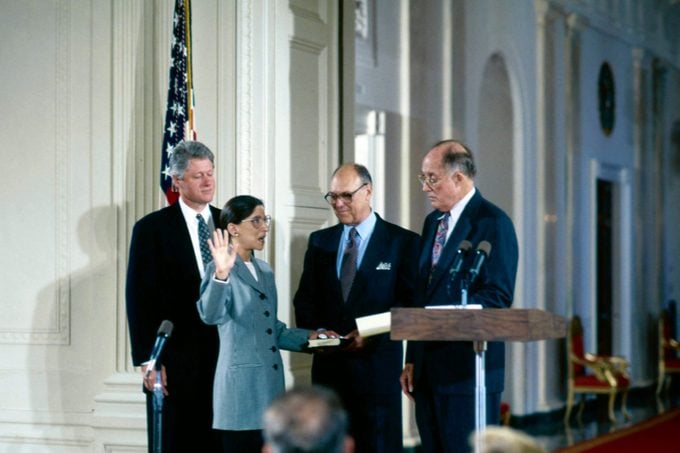
Ginsburg went from arguing cases before the Supreme Court to hearing them. In 1980, President Jimmy Carter appointed her to the U.S. Court of Appeals for the DC Circuit. “Early on, my mom followed my dad to New York, and, later on, he followed her to Washington,” son James Ginsburg, who was born in 1965, told the New Yorker. Then in 1993, President Bill Clinton nominated Ginsburg to the Supreme Court. She became the second female justice (after Sandra Day O’Connor), the first Jewish justice since 1969, and the first female Jewish justice ever.
She’s one of only four females justices in history
Ginsburg has gone on to hit more milestones during her lifetime appointment to the Court: She became the only female justice on the bench between O’Connor’s retirement in 2006 and Sonia Sotomayor’s appointment in 2009. Currently, there are three with the addition of Elena Kagan in 2010; but to put this in perspective, out of all the 114 Supreme Court Justices ever, 110 (96.5 percent) have been men. “I’m sometimes asked when will there be enough [women on the Supreme Court]? And when I say when there are nine, people are shocked,” Ginsburg said at a conference in 2012. “But there’d been nine men, and nobody’s ever raised a question about that.”
Since 2010, RBG was also the most senior justice on the bench.
She had “In the year of Our Lord” removed from Supreme Court bar certificates
At the Washington, D.C. synagogue Adas Israel Congregation in 2018, Ginsburg described how at the beginning of her time as a justice, she was asked to speak up on behalf of Jewish attorneys of the Supreme Court Bar who did not want “In the Year of Our Lord” to be written on their membership certificates. “Every year they would get half a dozen or so complaints from Orthodox Jews who said, ‘We’re so proud of our membership in the Supreme Court Bar, but we can’t frame our certificate and put it on the wall because it says, ‘In the Year of Our Lord,’ and he’s not our lord,” Ginsburg said. Another justice, whose name she would not reveal, told her the wording was good enough for the five Jewish justices before her. “I said, ‘It’s not good enough for Ginsburg,'” she remembered. After speaking with Chief Justice John Roberts, the wording was changed to simply the year if members preferred. “Now it’s the way it should be—it’s your choice,” she said.
She gained notice for her impassioned dissents
As a Supreme Court Justice, Ginsburg became known for not only her powerful majority opinions but also fiery dissents. (To answer one of the political questions you’ve been embarrassed to ask, that’s the opinion that goes against the majority.) In her dissents, she wrote, and later took to reading out loud from the bench, in colloquial language that broke with legal tradition and even called upon Congress to change unfair laws. Franke’s favorite Ginsburg dissent was one of those law-changing cases, 2007’s Ledbetter v. Goodyear Tire and Rubber Co. In this case, the majority found the female plaintiff’s claim to sex-based pay discrimination was not valid because the statute of limitations had run out (she had found out about it after working there for many years). “Justice Ginsburg’s dissent for four members of the Court was a classic example of a justice educating her colleagues,” Franke says. Ginsburg “explained to the other members of the Court, as well as the public, how discrimination works, pointing out how ludicrous the majority’s approach to the law was in light of how discrimination operates in the real world.”
In 2009, President Obama signed the Lilly Ledbetter Fair Pay Act, which relaxed the statute of limitations on fair pay complaints and became one of the moments that changed women’s history. “I like to think most of my dissents will be the law someday,” Ginsburg said at the University of Michigan in 2015.
She was the first justice to officiate a same-sex marriage
RBG has taken her crusade to end sex discrimination even further with her support of same-sex marriage, which was made legal under federal law in 2015. In 2013, just after the Supreme Court struck down two laws restricting same-sex marriage, Ginsburg became the first Supreme Court justice to officiate one, at the wedding of Kennedy Center President Michael M. Kaiser to economist John Roberts in Washington, DC. “I think of how the constitution begins: ‘We the people of the United States, in order to form a perfect union,'” Ginsburg said of Constitutional rights in a 2014 interview. “But we’re still striving for that more perfect union. And one of the perfections is for ‘we the people’ to include an ever enlarged group.”
She and her daughter became the first mother-daughter to teach on the same law faculty
Coming full circle, RBG has inspired the next generation of women to pursue the law—including her own daughter, Jane. The younger Ginsburg followed in her mother’s footsteps to become a law professor at Columbia, where she still teaches today. “I believe we are the first mother-daughter law school teaching team,” RBG wrote on a Columbia Reunion questionnaire. On another reunion questionnaire under “Memorable Law School Moments,” the elder Ginsburg wrote, “Now Columbia Law Professor Jane C. Ginsburg, then age four, called out from a Kent Library balcony seat as I received my diploma, ‘That’s my Mommy!'”
They are also the first mother-daughter pair to attend Harvard Law School (where Jane graduated from). Receiving an award at Harvard presented by Jane, RBG said with emotion, “An award from one’s child, as all parents here know, is something truly to cherish.”
She’s the only Supreme Court Justice to become a pop culture icon
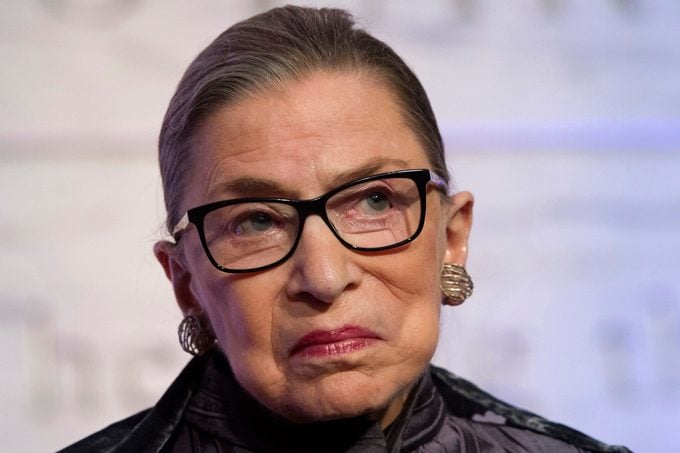
Before her death, Ginsburg was at the height of her popularity as young people continued to embrace her as a role model for justice, perseverance, and female empowerment. Her trademark glasses, bun, and fancy jabots (the lace collars she’s fond of) make her a favorite for Halloween costumes. Internet memes aplenty began with then-law student Shana Knizhnik’s “Notorious RBG” Tumblr (now a book): A takeoff of the late, very large rapper known as “Notorious BIG,” the nickname highlighted the juxtaposition between the modest manner of the diminutive justice and her tremendous force on the bench. Kate McKinnon’s hilarious impersonation of RBG on Saturday Night Live ends with the line, “You’ve been Gins-burned!” (“I would like to say ‘Gins-burned’ sometimes to my colleagues,” RBG quipped at Sundance.) In addition to the Oscar-nominated documentary RBG, Felicity Jones portrayed Ginsburg in the 2018 film On the Basis of Sex. “I have no doubt that Justice Ginsburg will persist until she takes her last breath, which I hope is many years from now,” Franke says. Next up? Ginsburg would love an Equal Rights Amendment. Plus, Ginsburg is being honored on one of the new 2023 postage stamps.
Now read up on some of Ginsburg’s best quotes.
Sources:
- Oyez: “Ruth Bader Ginsburg”
- NPR: “Justice Ruth Bader Ginsburg Reflects On The #MeToo Movement: ‘It’s About Time'”
- Academy of Achievement: “Ruth Bader Ginsberg”
- The Association of American Law Schools: “2015 Annual Meeting Newspaper – Herma Hill Kay and Ruth Bader Ginsburg: Leaders and Trailblazers in Legal Education”
- ACLU: “TRIBUTE: THE LEGACY OF RUTH BADER GINSBURG”
- Columbia Magazine: “Without Precedent: Ruth Bader Ginsburg Honored at Law School”
- Supreme Court of the United States: “Justice 1789 to Present”
- SCOTUS Blog: “Empirical SCOTUS: Justice Stevens, the longest-living Supreme Court justices, and other age milestones”
- The White House, President Barack Obama: “FACT SHEET: New Steps to Advance Equal Pay on the Seventh Anniversary of the Lilly Ledbetter Fair Pay Act”
- The Washington Post: “Ginsburg to officiate same-sex wedding”

